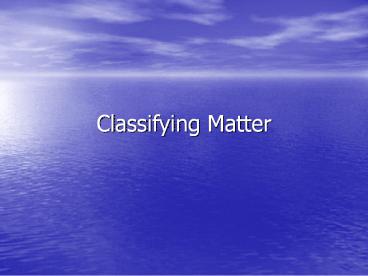Classifying Matter - PowerPoint PPT Presentation
1 / 18
Title:
Classifying Matter
Description:
Classifying Matter Atom the smallest unit of an element that maintains the properties of that element. ATOM Pure Substance A sample of matter, either a single ... – PowerPoint PPT presentation
Number of Views:145
Avg rating:3.0/5.0
Title: Classifying Matter
1
Classifying Matter
2
ATOM
- Atom the smallest unit of an element that
maintains the properties of that element.
3
Pure Substance
- A sample of matter, either a single element or a
single compound, that has definite chemical and
physical properties
Figure 14, Page 22
4
Elements
- A pure substance that contains only one kind of
atom - All atoms of the same element have the same
atomic number
5
Compounds
- A pure substance that is made up of two or more
different elements joined by chemical bonds.
6
Molecules
- The smallest unit of a substance that keeps all
of the physical and chemical properties of that
substance.
7
All of the following are molecules, but are they
compounds or elements?
Element
- Br2
- H2O
- O2
- O3
- C12H22O12
Compound
Element
Element
Compound
8
Mixtures
- A combination of two or more substances that are
not chemically combined. - Examples are air, ice tea, and even cake batter
- The proportions of the substances can vary
9
Homogeneous Mixtures
- have a uniform structure or composition
throughout - any two samples taken will have the same
proportions of ingredients - Examples Gasoline, air, and syrup
10
Heterogeneous Mixtures
- NOT evenly mixed.
- Different regions will have different proportions
- Examples Pulpy Orange Juice, chocolate chip
cookie dough, and granite.
11
Homogeneous and Heterogeneous Mixtures
12
(No Transcript)
13
Separating Mixtures
- Since mixtures are just physically combined, they
can be separated.
14
Separating Mixtures
- Some Methods include
- Filtering separation of a mixtures components
through differences in particle size - Decanting a fancy term for separating two
components by pouring - Distillation used to separate two liquids based
on their differences in boiling points - Magnetism used to separate magnetic substances
- Evaporation removing a liquid to leave a solid
behind - Centrifuge separates substances of different
densities using a fast rotational motion - Chromatography Separates two substances by
using a mobile phase and a stationary phase
15
Physical Changes
- A change of matter from one form to another
without changing the substance itself. - A ? A
- Examples phase changes, mixtures
16
Chemical Changes
- when one or more substances change into entirely
new substances with different properties - A B ? C (reactants go to products)
17
(No Transcript)
18
Chemical or Physical
- Frying an egg - Chemical
- Boiling Water - Physical
- Sanding a wooden plank - Physical
- Digesting food - Chemical
- Popping a balloon - Physical































